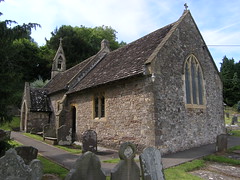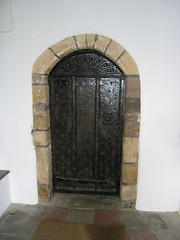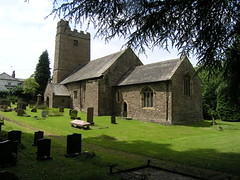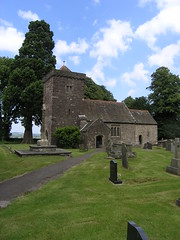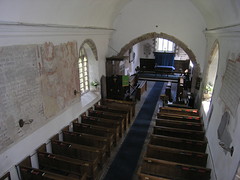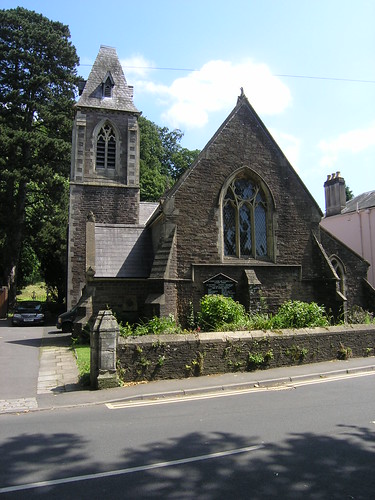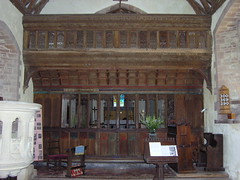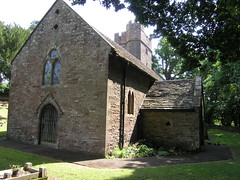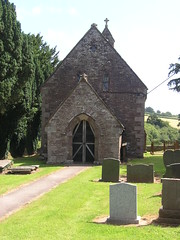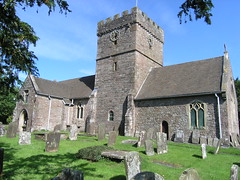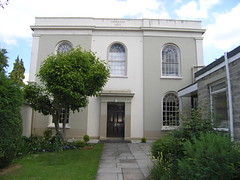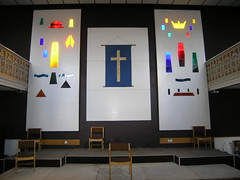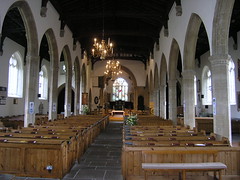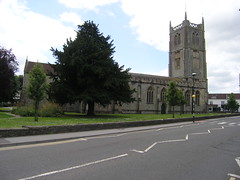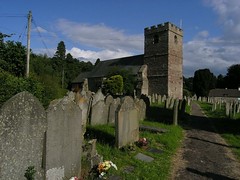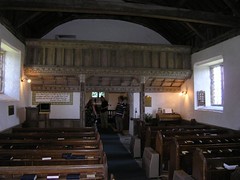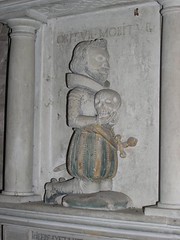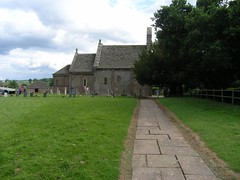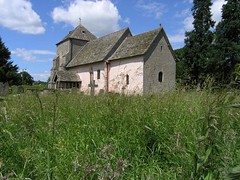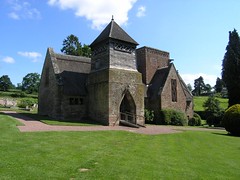Almost entirely rebuilt by Ewan Christian, with a very fun tall west bellcote. retained from its predecessor and typical of the ubiquitous Prichard.
Friday, September 12, 2008
St Dyfrig's Church, Llanvaches, Gwent
This was recommended for a visit by the keyholder at Llantrisant. Actually I found it rather dull. The tower has a saddleback top, but is patently a run out of money job, the base of an intended taller tower. John Newman's Gwent (BoW) is generally very good but he gives no mention to one of the sweetest medieval doors I have seen.
St Llywel's Church, Llanllowell, Gwent
A small single-celled church with bellcote, and very restored. Scraped interior of some charm. [Locked - no keyholder information. However there was a key available, but try as I might the lock confounded me. I walked around the church - no other door in use (small priests door well shut with blocked keyhole) so this had to be the way in. Key in - turn - unlocked - try door - still locked! I put away the key three times and then tried again. In the end I cracked it. Insert key - turn -unlock - remove key - turn upside down - turn key as if to lock door - unlock - door open. Hurrah! Locking door was reversal - key upside down , unlock, key in again normally, lock! Has anyone else ever found a dual bolted door lock operated with a single key?]
Church of St Peter, St Paul & St John, Llantrisant, Gwent
A large church in one of the most beautiful churchyards I have visited, with some superb mature trees. Aisleless nave with west tower and lower narrower chancel. The tower looks late medieval, in fact nothing seems earlier than the C16 here apart from one lancet window in the chancel perhaps. Inside the nave is remarkably wide. Good modern east window by Geoffrey Robertson, abstract design but spoilt somewhat by a near traditional central figure of The Good Shepherd.
St Andrew's Church, Tredunnock, Gwent
Reached down a path and through an ironwork arch with lamp. A charming small church with three norman windows (N nave - blocked, N & S chancel) and west tower and south porch. Inside part of a Roman gravestone but nothing of real interest but as a whole a charming church.
Church of St Cybi, Llangibby, Gwent
West tower, long nave and chancel. The exterior does not promise much but inside there is a west gallery (with organ) and wall paintings from different periods
Catholic Church of St Francis Xavier & St David Lewis, Usk, Gwent
Catholic Church of St Francis Xavier & St David Lewis, Usk, Gwent
Originally uploaded by ChurchCrawler
A small but well detailed church all by Charles Hansom, nave south aisle and chancel of 1847 and N transeptal tower and spire of 1865.
Congregational Chapel (former) Usk, Gwent
In the Twyn Square was the Nags Head where I was to have an excellent lunch and the former Congregational Chapel now a gallery, Dec with a "west" porch and NW overgrown spired turret (i.e. not quite a tower and spire!).
Priory Church of St Mary, Usk, Gwent
A large church seemingly grouped around a central tower, but that tower now serves as the chancel of the church and has blocked E S and N arches. Long nave, the western part aisleless, and north aisle with vaulted north and west porches. Perp screen across nave and aisles, as if in Devon. Behind this is a notable organ, with strange fans of pipes coming out from the case almost like horns.
St Jerome's Church, Llangwm Uchaf, Gwent
On entering I gasped as there is a superb and complete C15 rood screen and loft (albeit much restored by Seddon) to the west of the chancel arch.
I am told that one of the Llangwm churches is to close, and there are only some six regular church-goers. St John's looks like the decision is already taken inside, but it is small and would be easier to heat. St Jerome's is larger and more of a financial headache to keep going, as well as being architecturally and historically significant. I hope it remains open. The loss of the interior of Llangwm Isaf to conversion, perhaps to a house, would be easier to bear and easier to get past conservation groups and planners than the closure of Llangwm Uchaf would be. Perhaps the money from the sale of the smaller church would preserve the larger one for years to come. And with some proper tourist signs and local publicity, visitor numbers could be increased at St Jerome's and be a source of further income. I never saw another visitor here on one of the sunniest of this year's summer days and although I did enjoy the tranquility I would rather lose some of that to ensure the church's survival.
I am told that one of the Llangwm churches is to close, and there are only some six regular church-goers. St John's looks like the decision is already taken inside, but it is small and would be easier to heat. St Jerome's is larger and more of a financial headache to keep going, as well as being architecturally and historically significant. I hope it remains open. The loss of the interior of Llangwm Isaf to conversion, perhaps to a house, would be easier to bear and easier to get past conservation groups and planners than the closure of Llangwm Uchaf would be. Perhaps the money from the sale of the smaller church would preserve the larger one for years to come. And with some proper tourist signs and local publicity, visitor numbers could be increased at St Jerome's and be a source of further income. I never saw another visitor here on one of the sunniest of this year's summer days and although I did enjoy the tranquility I would rather lose some of that to ensure the church's survival.
St Jerome's Church, Llangwm Uchaf, Gwent
At the end of the road is St Jerome's church. It lies well below the road level and there is a long path down and around the west front to the south porch. The setting is idyllic and peaceful, and to be honest no-one would know it was here. The tower is in a very unusual position north of the chancel. No aisles.
St John's Church, Llangwm Isaf, Gwent
At main-road Llangwm a small sign sends you off to a church of note. And you arrive first at this church. Small, a simple rectangle with a west porch and a bellcote over the chancel arch. The west front and porch possible medieval but the rest rebuilt in the C19 by Prichard and very dull. It was open but inside one of the main features were the cobwebs across every entrance to the pews! I wonder how many people come here and go away disappointed, missing travelling a little bit further on and round a bend to the end of this no through road?
St Peter's Church, Newchurch, Gwent
Not a large church but one with stunning views from its churchyard. Ancient west tower and porch, the rest looks C19. Locked and no keyholder information. Oh dear the day was beginning to feel unsuccessful.
(Post visit - I am informed that this church is likely to be declared redundant before the year is out)
(Post visit - I am informed that this church is likely to be declared redundant before the year is out)
St Thomas a Becket's Church, Shirenewton, Gwent
(To my shame I am lagging some two-three months behind in my write-ups. This crawl is July 1st 2008)
This seems to be a principally Victorian church built around an ancient central tower. To the north a large extension is under construction for parish rooms I assume. The church was padlocked shut, all the notices about contacts inside the porch.
I chose a likely house (and as it was the house which does have a key!) but people were out but I also met a lovely lady gardening who got the parish magazine and with local knowledge between us we attempted to contact six different people all of whom were out. In fact this lady had a key until a year ago. She couldn't understand it, as she says the church is usually open every day. I thanked her and set off to my next target.
This seems to be a principally Victorian church built around an ancient central tower. To the north a large extension is under construction for parish rooms I assume. The church was padlocked shut, all the notices about contacts inside the porch.
I chose a likely house (and as it was the house which does have a key!) but people were out but I also met a lovely lady gardening who got the parish magazine and with local knowledge between us we attempted to contact six different people all of whom were out. In fact this lady had a key until a year ago. She couldn't understand it, as she says the church is usually open every day. I thanked her and set off to my next target.
Ebenezer Baptist Chapel, Keynsham, Somerset
A handsome chapel externaly, set back from the High Street and almost opposite the Methodist Chapel. Built 1834-5, the architect was Henry Rumley who designed most of the rebuilt houses on the West and North sides of Queen Square in Bristol, also c. 1833-5.
Ebenezer Baptist Chapel, Keynsham, Somerset
Unexpected is the revamped interior of this chapel, done in the 1970s.
Victoria Methodist Church, Keynsham, Somerset
I know little about this simple chapel which has a prominent corner site on the High Street. Its name suggests a date towards the very end of the C19. Modern extensions at the rear, and a newly fashioned entrance to the street, but these do not detract from the Perp Gothic front.
St Dunstan's Catholic Church, Keynsham, Somerset
Keynsham's Catholic church is a fairly typical simple building of its period, dating from 1935. Sadly I was unable to get inside, so I missed seeing an unexpected feature, the C18 Stations of the Cross.
St John the Baptist, Keynsham, Somerset
The chancel is fairly packed with monuments (my flickr photostream contains nearly 50 pictures of this church and its monuments), my picture here shows Sir Thomas Bridges d 1661. The colouring of this monument seems to have been quite recently redone. Sir Thomas kneels in the central niche with standing angels flanking him in their own recesses.
St John the Baptist, Keynsham, Somerset
Inside, and actually the church is very spacious, if a little dark. It is not known if there was a clerestory before the old tower fell, but other churches in the area do not have them - e.g. St Luke Brislington which dates from a similar time.
St John the Baptist, Keynsham, Somerset
I spent an interesting couple of hours in Keynsham photographing the churches there. This is the parish church, a long and relatively low spreading church, largely C15 but with an odd tower of 1634, built after the previous tower collapsed two years earlier during "tempestuous weather...with hideous clapps of thunder". A closer look reveals the chancel is largely C13.
Church of St Cydawg, Clodock, Herefs
one of the "churches the Victorians forgot", quite a large but aisleless building which I have visited some four or five times in the past. However for the first time I walked to the back of the churchyard attracted by the noise from the fast flowing river and its weir.
Church at St Margarets, Herefs
I was expecting something much more isolated and not in such tip-top condition. People come here to see the medieval rood screen, and can now choose as a souvenir to buy a guidebook, a selection of postcards and even a DVD-Rom. It is evident that tourism has found this church despite the remoteness. This was my first visit, but I am not mided to return in a hurry, but am very glad to have seen it.
St Faith, Bacton, Herefs
This is a simple rectangular single cell church with a broad rectangular west tower built into the slope of the hill. Inside the roof differs over nave and chancel, otherwise there is no division. We came to see Blanche Parry, who kneels prayerfully alongside her mistress - an oddly shaped Queen Elizabeth (the First of course). Other things also caught the eye, including some rather good glass, and a couple more very rustic wall monuments including this chappie ALexander Stanton d1620.
Church of St Mary, Abbey Dore, Herefs
I think this was the fourth visit here for me, but one I was happy to repeat. The ruined cistercian church was partially re-roofed in the C17 and a tower added in the SE angle of the crossing. The nave, once ten bays long, has largely disppeared apart from the first bay of the arcades and a number of ornate roof bosses preserved inside in the ambulatory. Screen, pulpit, pews and stalls all date from the C17.
SS Mary & David, Kilpeck, Herefs
Was another 2007 visit for me, and one I was not keen to revisit. Now my memories here (when I had the church to myself last time) are tainted by new ones of a group of wierdos walking around with broken coathangers, and a constant trickle of new visitors coming to look at the near-perfect Norman parish church with its cute and comical (and one very rude) carvings.
St Catherine's Church, Hoarwithy, Herefs
A revisit to this church and to the pub for lunch. The description is my original one.
Stuck on a Herefordshire hillside looking out over the River Wye is an Italian Tuscan church, a humble church of the 1840s (the current nave structurally) was transformed by the addition of a campanile and cloister walk running along the south wall of the church. It turns into an atrium on the west wall and a porch in the NW corner. If this isn't enough then to the south is a mature Monkey Puzzle Tree (well that's what I have always called them). Inside is jaw-dropping, because within the east end of the church Seddon has created an almost Byzantine effect by introducing four piers with absurdly large carved capitals, to create a crossing and transepts effect. The east apse glistens with a golden mosaic fresco. In actuality the parts are ugly, but the sum of the parts is astounding, and quite unlike anything you would expect in the English countryside
Stuck on a Herefordshire hillside looking out over the River Wye is an Italian Tuscan church, a humble church of the 1840s (the current nave structurally) was transformed by the addition of a campanile and cloister walk running along the south wall of the church. It turns into an atrium on the west wall and a porch in the NW corner. If this isn't enough then to the south is a mature Monkey Puzzle Tree (well that's what I have always called them). Inside is jaw-dropping, because within the east end of the church Seddon has created an almost Byzantine effect by introducing four piers with absurdly large carved capitals, to create a crossing and transepts effect. The east apse glistens with a golden mosaic fresco. In actuality the parts are ugly, but the sum of the parts is astounding, and quite unlike anything you would expect in the English countryside
St Edward, Kempley, Glos
Stands more centrally placed to the old church and dates from the early C20. The exterior is quite inspired, with a north porch tower with gabled top, and a near windowless church with a very large diaper traceried window filling the west wall. The exterior promised more than the interior delivers, my opinion but not shared by others.
St Mary, Kempley, Glos
The church is in the care of English Heritage, a largely Norman church, famed for its surviving wallpaintings which in the chancel are among the oldest in England. C12.
St Bartholomew, Much Marcle, Herefs
A sign directs you to the church and into a cul-de-sac where even the smallest car has difficulty turning around. I was here a few years back. ChurchCrawlers tried out the seat in the yew tree, admired the monuments (and especially Blanche Mortimer, and a sweet hedgehog at the feet of a lady on the swankiest monument in the church. There were also a couple who we nicknamed "The Smugs" due to the rather self-satisfied expressions on their faces!). Members of our party received information from the enthusiastic lady churchwarden about the Kempe stained glass.
All Saints, Brockhampton by Ross, Herefs
All Saints dates from the early C20, has a central tower and a short south porch tower with half-timbered bellstage. The church itself is thatched and all is of the Arts & Crafts period. Inside transverse stone arches, and fine attention to detail. Burne-Jones tapestries, cute conical suspended light fittings, and a set of stalls with panelled fronts, each panel differing from the others and depicting local flora.
Subscribe to:
Comments (Atom)
